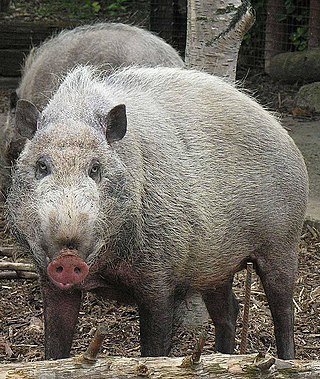
Sus is the genus of wild and domestic pigs, within the even-toed ungulate family Suidae. Sus include domestic pigs and their ancestor, the common Eurasian wild boar, along with other species. Sus species, like all suids, are native to the Eurasian and African continents, ranging from Europe to the Pacific islands. Suids other than the pig are the babirusa of Indonesia, the pygmy hog of South Asia, the warthogs of Africa, and other pig genera from Africa. The suids are a sister clade to peccaries.

The wild boar, also known as the wild swine, common wild pig, Eurasian wild pig, or simply wild pig, is a suid native to much of Eurasia and North Africa, and has been introduced to the Americas and Oceania. The species is now one of the widest-ranging mammals in the world, as well as the most widespread suiform. It has been assessed as least concern on the IUCN Red List due to its wide range, high numbers, and adaptability to a diversity of habitats. It has become an invasive species in part of its introduced range. Wild boars probably originated in Southeast Asia during the Early Pleistocene and outcompeted other suid species as they spread throughout the Old World.

A peccary is a pig-like ungulate of the family Tayassuidae. They are found throughout Central and South America, Trinidad in the Caribbean, and in the southwestern area of North America. They usually measure between 90 and 130 cm in length, and a full-grown adult usually weighs about 20 to 40 kg. They represent the closest relatives of the family Suidae, which contains pigs and relatives. Together Tayassuidae and Suidae are grouped in the suborder Suina within the order Artiodactyla.
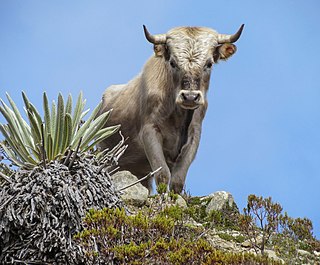
A feral animal or plant is one that lives in the wild but is descended from domesticated individuals. As with an introduced species, the introduction of feral animals or plants to non-native regions may disrupt ecosystems and has, in some cases, contributed to extinction of indigenous species. The removal of feral species is a major focus of island restoration.

Breeding back is a form of artificial selection by the deliberate selective breeding of domestic animals, in an attempt to achieve an animal breed with a phenotype that resembles a wild type ancestor, usually one that has gone extinct. Breeding back is not to be confused with dedomestication.
Hog-dog rodeo or hog-dogging, is a spectator event that simulates wild or feral boar hunting with dogs. It requires specially trained and bred "hog dogs" that are used to bay and sometimes catch a hog or boar. In most cases, bay dogs psychologically control the pig and no physical contact occurs. In some cases, however, such as Uncle Earl's Hog Dog Trials, along with bay dog events, catch dog events have been included in the past. In these, specially bred and equipped dogs caught and held the hog by the ears before the animals were quickly separated by a person who hog-tied the pig.

Game or quarry is any wild animal hunted for animal products, for recreation ("sporting"), or for trophies. The species of animals hunted as game varies in different parts of the world and by different local jurisdictions, though most are terrestrial mammals and birds. Fish caught non-commercially are also referred to as game fish.

A feral pig is a domestic pig which has gone feral, meaning it lives in the wild. The term feral pig has also been applied to wild boars, which can interbreed with domestic pigs. They are found mostly in the Americas and Australia. Razorback and wild hog are Americanisms applied to feral pigs or boar–pig hybrids.

The domestication of vertebrates is the mutual relationship between vertebrate animals including birds and mammals, and the humans who have influence on their care and reproduction.
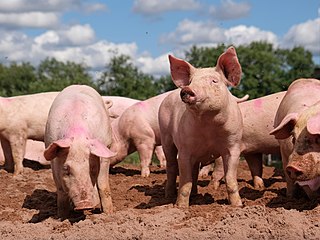
The pig, often called swine, hog, or domesticpig when distinguishing from other members of the genus Sus, is an omnivorous, domesticated, even-toed, hoofed mammal. It is variously considered a subspecies of Sus scrofa or a distinct species. The pig's head-plus-body length ranges from 0.9 to 1.8 m, and adult pigs typically weigh between 50 and 350 kg, with well-fed individuals even exceeding this range. The size and weight of hogs largely depends on their breed. Compared to other artiodactyls, a pig's head is relatively long and pointed. Most even-toed ungulates are herbivorous, but pigs are omnivores, like their wild relative. Pigs grunt and make snorting sounds.

The bushpig is a member of the pig family that inhabits forests, woodland, riverine vegetation and cultivated areas in East and Southern Africa. Probably introduced populations are also present in Madagascar. There have also been unverified reports of their presence on the Comoro island of Mayotte. Bushpigs are mainly nocturnal. There are several subspecies.

The pygmy hog is the rarest species of pig in the world today, and is the only species in the genus Porcula. It is also the smallest species of pig in the world. Endemic to India, the pygmy hog is a suid native of the alluvial grasslands in the foothills of the Himalayas, at elevations of up to 300 m (980 ft). Populations of pygmy hogs were once widespread in the tall, dense, wet grasslands in a narrow belt of the southern Himalayan foothills from north-western Uttar Pradesh to Assam, through southern Nepal and North Bengal, and possibly extending into contiguous habitats in southern Bhutan. Due to human encroachment and destruction of the pygmy hogs’ natural habitat, the species was thought to have gone extinct in the early 1960s. However, in 1971, a small pygmy hog population was rediscovered as they were fleeing a fire near the Barnadi Wildlife Sanctuary in Assam. Today, the only known population of pygmy hogs resides in Manas National Park in Assam, India. The population is threatened by livestock grazing, fires and poaching. With an estimated population of less than 250 mature individuals, the pygmy hog is listed as an Endangered species on the IUCN Red List, and conservation efforts such as captive breeding and re-release programs are currently being employed.
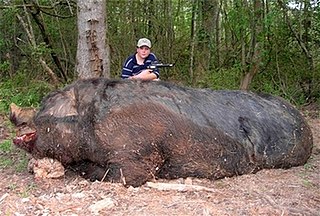
Monster Pig was the subject of a controversial 2007 story that initially ran in the news media as a report of an 11-year-old boy shooting a massive feral pig. The pig was claimed to have been shot during a hunt on May 3, 2007, by an 11-year-old boy named Jamison Stone. The location of the shooting was the Lost Creek Plantation, a commercial hunting preserve outside Anniston, Alabama, US. According to the hunters, the pig weighed 1,051 pounds (477 kg) and measured 9 feet 4 inches (2.84 m) in length.

The Celebes warty pig, also called Sulawesi warty pig or Sulawesi pig, is a species in the pig genus (Sus) that lives on Sulawesi in Indonesia. It survives in most habitats and can live in altitudes of up to 2,500 m (8,000 ft). It has been domesticated and introduced to a number of other islands in Indonesia.
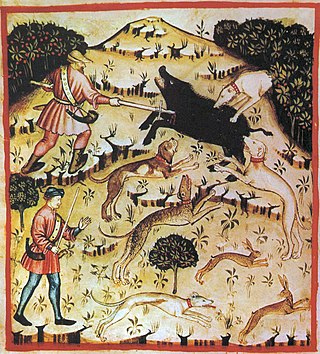
Boar hunting is the practice of hunting wild boar, feral pigs, warthogs, and peccaries. Boar hunting was historically a dangerous exercise due to the tusked animal's ambush tactics as well as its thick hide and dense bones rendering them difficult to kill with premodern weapons.
The Auckland Island pig is a feral landrace of domestic pig found on subantarctic Auckland Island, New Zealand. Its ancestors have inhabited the island since 1807, and, as an invasive species, has had a considerable environmental impact.

The feral goat is the domestic goat when it has become established in the wild. Feral goats occur in many parts of the world.

The banded pig also known as the Indonesian wild boar is a subspecies of wild boar native to the Thai-Malay Peninsula and many Indonesian islands, including Sumatra, Java, and the Lesser Sundas as far east as Komodo. It is known as the wild boar in Singapore. It is the most basal subspecies, having the smallest relative brain size, more primitive dentition, and unspecialised cranial structure. It is a short-faced subspecies with a white band on the muzzle, as well as sparse body hair, no underwool, a fairly long mane, and a broad reddish band extending from the muzzle to the sides of the neck. It is much smaller than the mainland S. s. cristatus subspecies, with the largest specimens on Komodo weighing only 48 kg.
The sale and consumption of pork is mostly illegal in Pakistan, a Muslim-majority country where halal dietary guidelines are observed. Being 96% Muslim majority makes pork hard to find. Like alcohol however, the meat may be consumed by non-Muslim citizens and foreigners who reside in the country.


















